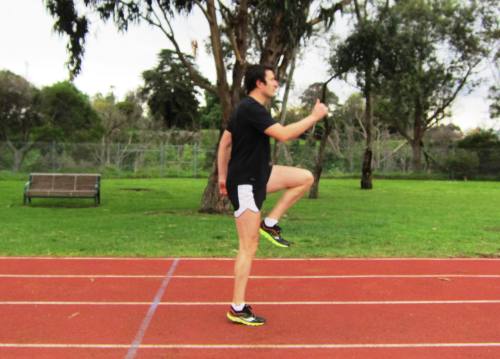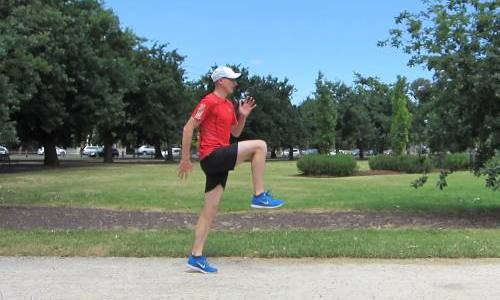
There are good arguments to be made for and against the regular use of running form drills in your training program. In elite running circles there are coaches making extensive use of drills and others that place little or no emphasis on form drills as such.
To me it’s like making the argument that strength training improves running performance. This is an area where numerous studies have shown benefits do arise, however some high level coaches and athletes don’t use it.
I can understand their perspective to a point. If you’re already running high mileage, doing specific speed, hills and plyometric bounding exercises you might be able to get away with not doing any strength training. It’s perhaps easier for the elite to make this call, whereas their recreational and less gifted counterparts (the majority of runners) desperately need the strength work to get a base level of capability, competence and injury resilience into their running.
I’ve made the argument before that recreational runners might enjoy relatively greater benefit from strength work than gifted and already well conditioned athletes. The case for running form drills can be made along similar lines, but only if you can pull the standard running drills apart and fully understand each component and what it seeks to model in relation to good technique. This is the purpose of this book: to help you to unlock the potential of running form drills so they become useful learning exercises.
I come from a non-structured athletics background as a runner and coach so my exposure to running drills was very limited until recent years. It was only after coaching recreational runners to improve their running technique that I began to fully understand the value drills could have in helping model and explain important parts of good running technique that could be practiced by runners of any ability level.
On the flip-side, many runners see elite or faster runners effortlessly practicing these complicated and sometimes silly looking drills and think to themselves I can never do this without looking ridiculous, ripping a hamstring off the bone or stabbing myself in the eye with my knee-cap.
As a relatively uncoordinated and anatomically challenged individual I sympathize with this perspective. I don’t do drills perfectly, I don’t do running perfectly either, but I’m not embarrassed about trying to improve as best I can. It took me months to get some semblance of competence over a basic suite of running drills. The plus side is this: I’m convinced if I can do it surely you can too.

The author - having a go!
Some complicated and aggressive drills can and should be left to well trained, stronger runners. Keep in mind that you need to approach all running drills as you would any exercise program, with caution and patience. A few of the drills discussed in this book are, at least initially, too difficult for novice runners to perform. But all can be gradually learned and practiced over time without high risk of tangle-footed humiliation.
Running form drills can be used by any healthy runner willing to put some time and effort into learning them. As you learn the drills you have the opportunity to understand more about your running and begin to transfer core elements into your regular runs, and especially the faster paced running you might do.
In my book Running Technique I made the argument that running with good form for short distances was more important than practicing drills. I also strongly promoted the benefits of strength training, which with running-like postures and movement patterns could be used as running technique training.
While I don’t retreat from those comments running drills have become another very useful tool in my kitbag of training interventions. As a person that believes in tackling a problem from multiple perspectives, running drills are another way to practice and implement components of good running form. Used in isolation by runners or coaches drills are likely to be ineffective, but they make up a handy piece of the overall training puzzle that includes: strength training, good footwear choices and training in a way that inherently stimulates better technique.
Strength training and other measures are discussed comprehensively in the original text of Running Technique but I felt there was a need for a shorter volume that singled out form drills as a separate and specific subject area because their use is so widespread and sometimes misunderstood.
While I deal with quite a bit of theory and research in Running Technique this book is a means for me to explain, and for the reader to apply and practice, what I’ve learned as a runner and coach.
As a couple of readers of Running Technique pointed out in their reviews I obsessively dealt with the ability to activate the posterior muscles, especially the glutes and hamstrings, as being critical elements that many recreational runners do poorly. I admit I’m still somewhat butt obsessed. However, I’ve given a great deal of further thought about how running form drills can help runners practice movement patterns that promote stable, more injury resilient and faster running. This book helps add balance to my original booty oriented running technique equation.

A March Drill
The side benefit for me as a teacher, has been to better understand and explain important elements of the running gait that can be modeled and practiced using drills. The A drills give you glute and hamstring activation and the trigger for hip flexion or knee drive. The B drills model the complete faster running pattern: muscle activation on contact, springy joint stiffness, fast swing leg retrieval, knee drive and leg extension needed in faster middle distance running.
There are of course other drills which I cover in detail that can be used to model combinations of movement and discrete aspects of running - smaller components of the bigger running picture.
But I’m getting ahead of myself. What does this book cover and why is it worth thinking about the how and why of running form drills?
I’ve presented the information logically and taken the time to justify why running form drills can be a helpful tool for runners and coaches looking to improve running technique. There is nothing more frustrating than training interventions where there isn’t a clear linkage between the training activity and how it is going to benefit performance and/or lead to improvement during running.
In my mind if you don’t understand what you are doing, you are going through the motions - this means even if there is benefit to what you are practicing there is no chance you are getting the most out of it. You are also at risk of becoming an expert at doing running drills but have no idea how to transfer this knowledge and skill into your daily training. If I achieve anything out of writing this book I’m hoping that helping runners avoid these traps is top of the list.
The early chapters of this book explain how running drills can be helpful and suggest some strategies for integrating them into your training program. These chapters also map each phase of the running gait cycle to each running drill. This way you have a clear idea about which aspects of technique each running drill is attempting to model.
This knowledge will help you unlock the why aspect of running form drills and give you the knowledge to practice transferring the movement patterns used into your running.
Instructions on how to do each drill follow with focus on the aspects most recreational runners get wrong and how to troubleshoot each drill so you can get the feel for how they should be done. In this section there are photos to help guide you but it’s also important to visit the online resources to watch the video demonstrations.
Finally, for those interested in learning more about good running technique I have included a sample, at the end of this work, from my first book Running Technique.
I hope you enjoy and find Running Form Drills helpful in achieving your running goals.
****